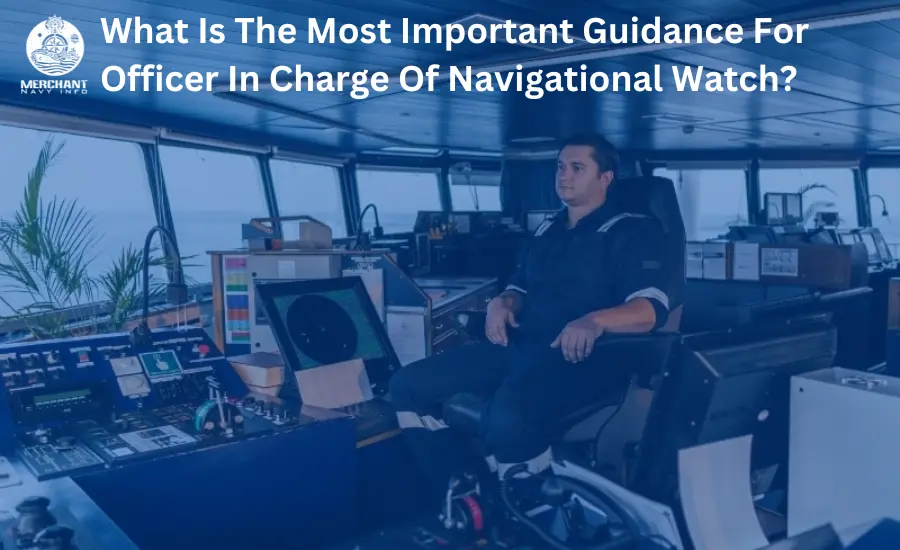
Explore the crucial role of duty of the navigating officer watch with our in-depth guide. From maintaining a vigilant lookout to adhering to COLREGs, discover the key responsibilities that ensure safe and efficient navigation. Learn the essential skills and practices to navigate challenges and safeguard maritime operations effectively.
One of the most crucial duty of the navigating officer on watch (OOW) is the safe and clear navigation of the ship. A ship has to sail through various weather and tidal conditions during its voyage. The navigating officer must know and figure out the ship’s sailing direction. He should also know the route well in advance and prepare for the given accordingly.
One of the more critical and dangerous things that you have to keep in mind when you are looking to navigate a ship is restricted visibility. The reason is because of fog, a lot of rain, or dust storms. When the ship’s officer comes onto the right information regarding these and more upcoming weather conditions, in such a condition. They should take all the much-needed precautions to make sure that the ship sails through safely. Even under a low-level visibility area, without confronting any collision or grounding accident.
Mentioned below are some of the more important points that must be considered. It would help if you had this for the safe navigation of the ship or vessel through restricted visibility areas of navigation.
The Navigating Officer Must Know Your Ship Inside-out
A properly trained and duty of the navigating officer needs to know every bit of their ship to prevent any scale accident. Begining from dimensions to the characteristics and specifics of the ship. In this case, the officer should know how the ship will behave under various hard circumstances. Such as in situations with restricted visibility. Here, the OOW must be aware of the stopping distance of the ship at any specific and particular RPM to keep control of the ship during emergencies.
Inform the Master
During times of low or little visibility, it is important to know that the ship’s master is on the bridge. The navigating officer must call or inform the master regarding the navigating condition. Ideally, The officer needs to inform the engine room and request the duty of the navigating officer to man and command the engine room just in case it is on “unmanned” time.
Appoint Adequate Man Power
Enough human resources must be on top of the bridge to maintain a close watch on the ship’s course of movement. Additional personnel must be appointed as “lookouts” at different locations and locations on the ship. If there is traffic in the area, one very important thing to remember is that the officer must inform the engine room. The reason is that they need to have enough human resources so that the engine is ready for immediate movement.
The Navigating Officer Must Have The Fog Horn Ready
Ensure the fog horn works properly for the restricted area. If the horn is air working, drain the line before opening the air to the horn.
Cut Down The Speed Speed
Limit the speed of the ship based on the visibility level. If the visibility is restricted, bring down the ship to movement RPM.
Ensure Navigation Equipment and Light Are doing their job Properly
Ensure that all critical navigating equipment and navigation lights are working properly and to the best of their capacity during restricted visibility. The navigating officer must properly check the navigation charts for proper routing and work out a good radar watch.
Stop All Other Works is the duty of the navigating officer
Even though it might be obvious. However, never multi-task during restricted visibility, even if more than enough people are on the bridge. Also, end other deck work because order the crew to go to their respective rooms. This is to prevent and minimize injury to personnel working hard on the open deck in case of collision; alternatively, grounding occurs.
Open/Close Bridge Doors
Make sure that the bridge door is kept constantly open and is without any obstruction for easy and smooth bridge wing access (Considering and keeping in mind that the bridge wing is not enclosed). Moreover, close all the various bridge openings in case of dust or sand storms.
Shut Ventilation
If the ship is moving through a dust storm, the ventilation fans and accommodation/ engine room ports must be closed simultaneously. This is done to stop sand particles from entering the bridge, accommodation, and engine room.
The Navigating Officer Should Follow All Procedures
Follow all the critical and very important procedures at the time-restricted visibility. As already mentioned in COLREG Rule -19. In addition, monitor channels 16,17 and more channels in the radio and make sure that all critical parameters of the ship are met. This includes things such as the latitude and longitude, time, speed and many other things noted in the logbook.










